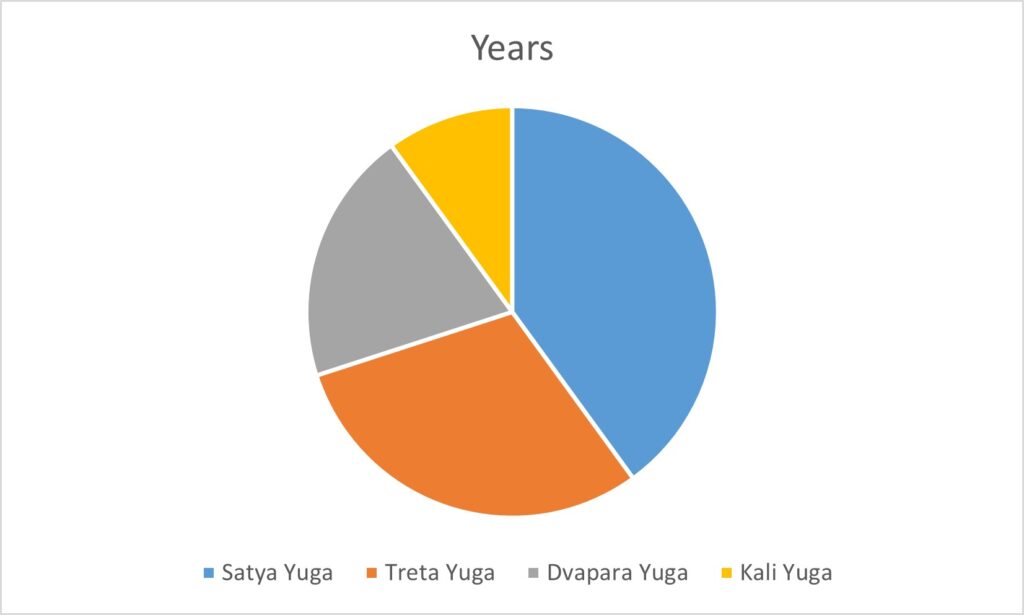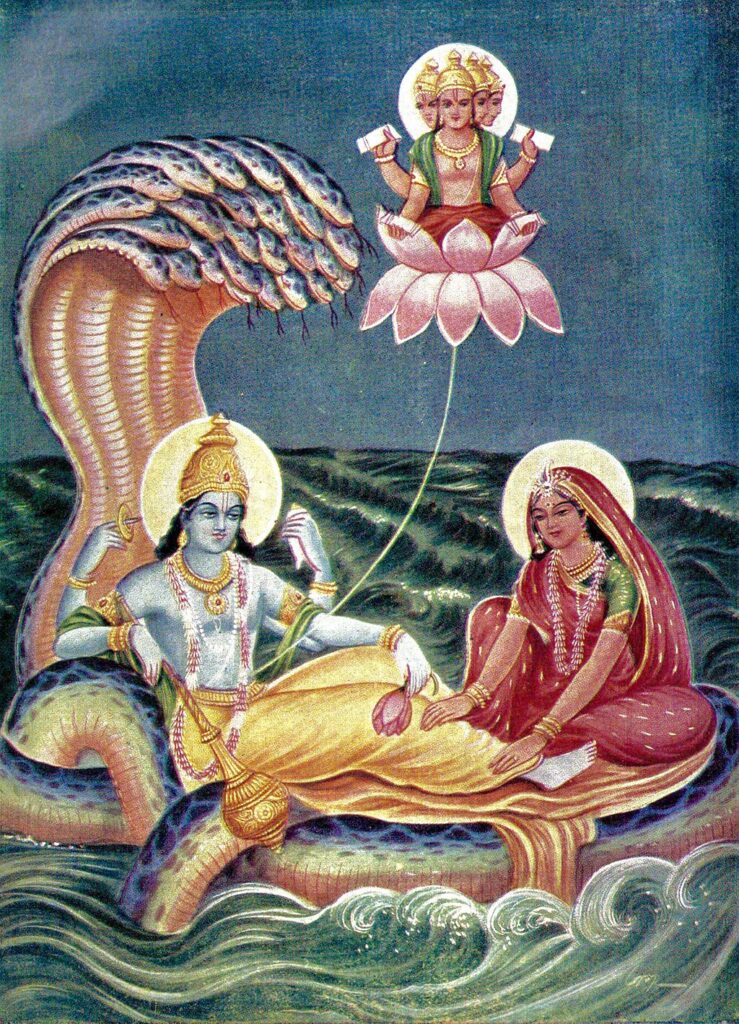
The Hindu worldview is centered on the idea of eternal and cyclical time, which is closely linked to the concept of the soul (atman). Hindus believe that the true self exists forever, not only in the future but also in the past. Hinduism or Sanatan Dharma does not have a beginning or an end, and the end of one phase leads to the start of another. The destruction of the universe is only a sign of its rebirth. As a result, the material world is believed to undergo perpetual cycles of creation, preservation, and destruction. We are currently believed to be in the Kali Yuga, with approximately 5000 human years already passed and an estimated 427,000 years remaining until its conclusion.
According to Hinduism (Sanatan Dharma), there are four Yugas – Satya, Treta, Dvarapara, and Kali. A thousand cycles of these 4 Yugas are said to comprise a ‘Kalpa’ or a single day of Brahma. The same (a thousand cycles of 4 Yugas) is the duration of Brahma’s night. At the beginning of Brahma’s day, the universal entities come into being and life becomes manifest. When Brahma sleeps during his night, the water of the causal ocean floods the universal planetary systems sparing only the abode of Brahma and a few higher planets. Brahma lives for 100 years and at the end of his lifespan, a complete universal dissolution occurs causing the universe to unmanifest itself. Therefore the universe suffers partial destruction at the end of Brahma’s day and a complete dissolution at the end of his lifetime. The Vedic scriptures explain that the concept of time differs in various planetary systems. For example, 1 day of Brahma equals a 1000 cycle of four Yugas. Similarly, 1 celestial day (a day in the heavenly planets where demigods reside) equals 6 months by human calculation. Also, 1 celestial night equals 6 human months. In the next section, we shall illustrate the time span of the four Yugas.
sahasra yuga paryantam ahar yad brahmano viduh
ratrim yuga sahasrantam te ho ratra vido janah
(Bhagavad Gita 8.17)
–
A thousand ages taken together form the duration of Brahma’s day. Same is the duration of his night.
The Four Yugas –
Hindu concept of Time (Kala)
One cycle of the four yugas equals 12,000 years of the demigods. The demigods live on the heavenly planets and these planets suffer from both partial and complete universal dissolutions. In other words, these heavenly planets are destroyed at the end of Brahma’s day and also at the end of Brahma’s lifetime.

Anyways, returning to our topic of discussion, one celestial year consists of 360 celestial days and each celestial day (day & night) equals one year on the earth. Out of these 12000 celestial years, Satya Yuga comprises 4000 celestial years, Treta Yuga comprises 3000 years, Dvapara lasts for 2000 celestial years and Kali Yuga spans for 1000 divine years. The remaining 2000 divine years form the conjoining portions between the Yugas. Each Yuga is preceded by a period called ‘Sandhya’ that consists of as many hundreds of celestial years as there are thousands of years in that particular Yuga. Each Yuga is also followed by a period of ‘Sadhyansa’, which consists of as many hundreds of celestial years as there are thousands of years in that particular Yuga.
Timespan of Satya Yuga
Satya Yuga = 4000 celestial years + 400 celestial years of Sandhya + 400 celestial years of Sandhyansa
4000 celestial years = 4000 * 360 celestial days = 4000 * 360 * 1 human year = 1440000 human years
400 celestial years (Sandhya) = 400 *360 celestial days = 400 *360 *1 human year = 144000 human years
400 celestial years (Sandhyansa) = 400 *360 celestial days = 400 *360 *1 human year = 144000 human years
Hence the timespan of Satya Yuga = 1440000 +144000 +144000 human years = 1728000 human years
Timespan of Treta Yuga
Treta Yuga = 3000 celestial years + 300 celestial years of Sandhya + 300 celestial years of Sandhyansa
3000 celestial years = 3000 * 360 celestial days = 3000 * 360 * 1 human year = 1080000 human years
300 celestial years (Sandhya) = 300 *360 celestial days = 300 *360 *1 human year = 108000 human years
300 celestial years (Sandhyansa) = 300 *360 celestial days = 300 *360 *1 human year = 108000 human years
Hence the timespan of Satya Yuga = 1080000 +108000 +108000 human years = 1296000 human years
Timespan of Dvapara Yuga
Dvapara Yuga = 2000 celestial years + 200 celestial years of Sandhya + 200 celestial years of Sandhyansa
2000 celestial years = 2000 * 360 celestial days = 2000 * 360 * 1 human year = 720000 human years
200 celestial years (Sandhya) = 200 *360 celestial days = 200 *360 *1 human year = 72000 human years
200 celestial years (Sandhyansa) = 200 *360 celestial days = 200 *360 *1 human year = 72000 human years
Hence the timespan of Satya Yuga = 720000 +72000 + 72000 human years = 864000 human years
Timespan of Kali Yuga
Kali Yuga = 1000 celestial years + 100 celestial years of Sandhya + 100 celestial years of Sandhyansa
1000 celestial years = 1000 * 360 celestial days = 1000 * 360 * 1 human year = 360000 human years
100 celestial years (Sandhya) = 100 *360 celestial days = 100 *360 *1 human year = 36000 human years
100 celestial years (Sandhyansa) = 100 *360 celestial days = 100 *360 *1 human year = 36000 human years
Hence the timespan of Kali Yuga = 360000 + 36000 + 36000 human years = 432000 human years
Kali Yuga is believed to have commenced when Lord Krishna wrapped up His earthly pastimes. The year 3102 BC is hence considered to be the beginning of Kali Yuga. Therefore nearly 5000 human years of Kali-yuga have already passed till now and there are about 427000 human years remaining before the Kali Yuga concludes.
Lifespan of Brahma in Human years (Lifespan of the universe)
Brahma lives for 100 years. Each day of Brahma comprises a 1000 cycle of four yugas. The same applies to his night. Hence a 24-hour period of Brahma’s life comprises 2 such cycles. At the end of Brahma’s lifetime, the universe is entirely dissolved.

1 cycle of 4 Yugas = Satya Yuga + Treta Yuga + Dvapara Yuga + Kali Yuga = 1728000 + 1296000 + 864000 + 432000 = 4320000 human years
Therefore, 1 day of Brahma = 2 * (1000 cycles of 4 Yugas) = 2 * (1000 * 4320000) = 8,640,000,000 human years.
1 Year of Brahma = 360 * 8,640,000,000 human years = 3,110,400,000,000 human years
Brahma lives for 100 Years. Hence, the lifespan of Brahma in human years = 100 * 3,110,400,000,000 human years = 311,040,000,000,000 human years.
Therefore the lifespan of Brahma is 311.04 Trillion Human Years, which is also the destined lifespan of this universe.
Ancient Vedic History vs Modern Academic History
The traditional Hindu account of history differs from the commonly accepted academic view, emphasizing a glorious past and descent from learned sages (rishis), in contrast to the Western view of emergence from a primitive ancestry. The widely accepted Aryan invasion theory, which is taught in schools, is now being challenged and contested in intellectual circles, causing academia to reassess its assumptions about ancient Indian history. Regardless of the current academic stance, it is important for educators to acknowledge Hinduism’s unique perspective on its own history, which highlights a decline in civilization rather than a progressive evolution.